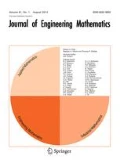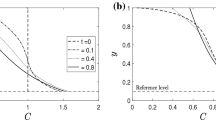Abstract
Modelling sediment transport in environmental turbulent fluids is a challenge. This article develops a model of the longitudinal transport of suspended sediment in environmental fluid flows such as floods and tsunamis. The model is systematically derived from a three-dimensional turbulence model based on the Smagorinski large eddy closure. Embedding the physical dynamics into a family of problems and analysing the linear dynamics of the system, the centre manifold theory indicates the existence of a slow manifold parameterised by macroscale variables. Computer algebra then constructs the slow manifold in terms of fluid depth, depth-averaged longitudinal velocities, and suspended sediment concentration. The model includes the effects of sediment erosion, advection and dispersion and the interactions between the sediment and turbulent fluid flow. Vertical distributions of the velocity and concentration in steady flow agree with established experimental data. For a pilot study, numerical simulations of the suspended sediment under long waves show that the developed model predicts physically reasonable sediment flow interaction.








Similar content being viewed by others
Notes
This and the following boundary conditions are expressed in terms of ensemble mean quantities. Consequently, terms in the mean of the products of fluctuation might appear and a closure for them invoked [24, §2.2.6]. We assume the closure is that such products of fluctuation are negligible in the boundary conditions.
References
Hunt JN (1954) The turbulent transport of suspended sediment in open channels. Proc R Soc Lond A 224(1158):322–335
van Rijn LC (1984) Sediment transport, part II: suspended load transport. J Hydraul Eng 110(11):1613–1641
Celik I, Rodi W (1988) Modeling suspended sediment transport in nonequilibrium situations. J Hydraul Eng 114:1157–1191
Fredsoe J, Deigaard R (1992) Mechanics of coastal sediment transport, vol 3., Advanced series on Ocean Engineering, World Scientific Publishing, Singapore
Wu W, Rodi W, Wenka T (2000) 3D numerical modeling of flow and sediment transport in open channels. J Hydraul Eng 126:4–15
Pittaluga M, Seminara G (2003) Depth-integrated modeling of suspended sediment transport. Water Resour Res 39(1137):11
Cao M, Roberts AJ (2012) Modelling 3D turbulent floods based upon the Smagorinski large eddy closure. In: Brandner PA, Pearce BW (eds) Proceedings of the 18th Australasian fluid mechanics conference, Australasian Fluid Mechanics Society
Aulbach B, Wanner T (2000) The Hartman–Grobman theorem for Caratheodory-type differential equations in Banach spaces. Nonlinear Anal 40:91–104
Potzsche C, Rasmussen M (2006) Taylor approximation of integral manifolds. J Dyn Differ Equ 18(2):427–460
Roberts AJ (2015) Macroscale, slowly varying, models emerge from the microscale dynamics in long thin domains. IMA J Appl Math 76:1–27
Cao M, Roberts AJ (2014) Modelling suspended sediment in environmental turbulent fluids. Tech. rep., arXiv:1407.1579
Schultz MP, Flack KA (2007) The rough-wall turbulent boundary layer from the hydraulically smooth to the fully rough regime. J Fluid Mech 580:381–405
Schultz MP, Flack KA (2013) Reynolds-number scaling of turbulent channel flow. Phys Fluids 25:025104
Georgiev DJ, Roberts AJ, Strunin DV (2009) Modelling turbulent flow from dam break using slow manifolds. In: Mercer GN, Roberts AJ (eds) Proceedings of the 14th biennial computational techniques and applications conference, CTAC-2008, ANZIAM J, 50:C1033–C1051
Roberts AJ, Georgiev DJ, Strunin DV (2008) Model turbulent floods with the Smagorinsky large eddy closure. Tech. rep., arXiv:0805.3192
Nezu I (2005) Open-channel flow turbulence and its research prospect in the 21st century. J Hydraul Eng 131:229–246
Rastogi AK, Rodi W (1978) Prediction of heat and mass transfer in open channels. J Hydraul Div 104:397–419
Keller RJ, Rodi W (1988) Prediction of flow characteristics in main channel/flood plain flows. J Hydraul Res 26(4):425–442
Mei Z, Roberts AJ, Li Z (2003) Modelling the dynamics of turbulent floods. SIAM J Appl Math 63(2):423–458
Wilcox DC (1998) Turbulence modeling for CFD, 2nd edn. DCW Industries Inc, Lake Arrowhead, CA
Davidson L (2003) An introduction to turbulence models. Tech. Rep. 97/2, Chalmers University of Technology, Department of thermo and fluid dynamics
Georgiev DJ, Roberts AJ, Strunin DV (2007) The dynamics of the vertical structure of turbulence in flood flows. In: Read W, Larson JW, Roberts AJ (eds) Proceedings of the 13th biennial computational techniques and applications conference, CTAC-2006, 48:C573–C590
Chanson H (2004) Hydraulics of open channel flow. Butterworth–Heinemann, Oxford
Cao M (2014) Modelling environmental turbulent fluids and multiscale modelling couples patches of wave-like system. PhD thesis, School of Mathematical Sciences, University of Adelaide
Roberts AJ (1996) Low-dimensional models of thin film fluid dynamics. Phys Lett A 212:63–72
Prokopiou T, Cheng M, Chang HC (1991) Long waves on inclined films at high Reynolds number. J Fluid Mech 222:665–691
Roberts AJ (2014) Model emergent dynamics in complex systems. SIAM, Philadelphia
Roberts AJ (1988) The application of centre-manifold theory to the evolution of systems which vary slowly in space. J Austral Math Soc Ser B 29:480–500
Roberts A (2008) The inertial dynamics of thin film flow of non-Newtonian fluids. Phys Lett A 372(10):1607–1611
Zedler EA, Street RL (2006) Sediment transport over ripples in oscillatory flow. J Hydraul Eng 132(2):180–193
Taylor GI (1953) Dispersion of soluble matter in solvent flowing slowly through a tube. Proc R Soc Lond A 219:186–203
Ribe NM (2001) Bending and stretching of thin viscous sheets. J Fluid Mech 433:135–160
Wu W (2004) Depth-averaged two-dimensional numerical modeling of unsteady flow and nonuniform sediment transport in open channels. J Hydraul Eng 130(10):1013–1024
Duan JG (2004) Simulation of flow and mass dispersion in meandering channels. J Hydraul Eng 130:964–976
Duan JG, Nanda SK (2006) Two-dimensional depth-averaged model simulation of suspended sediment concentration distribution in a groyne field. J Hydrol 327(3–4):426–437
Cellino M, Graf WH (1999) Sediment-laden flow in open channels under noncapacity and capacity conditions. J Hydraul Eng 125(5):455–462
Yoon JY, Kang SK (2005) A numerical model of sediment-laden turbulent flow in an open channel. Can J Ci Eng 32(1):233–240
Song T, Graf WH (1996) Velocity and turbulence distribution in unsteady open-channel flow. J Hydraul Eng 122(3):141–154
Kos’yan RD, Divinskiy BV, Krylenko MV, Vincent CE (2007) Modelling of the vertical distribution of suspended sediment concentration under waves with a group structure. In: OCEANS 2007—Europe. IEEE, pp 1–6. doi:10.1109/OCEANSE.2007.4302378
Osborne PD, Vincent CE (1996) Vertical and horizontal structure is suspended sand concentrations and wave-induced fluxes over bedforms. Mar Geol 131(3–4):195–208
Balmforth NJ, Mandre S (2004) Dynamics of roll waves. J Fluid Mech 514:1–33
Zedler EA, Street RL (2001) Large-eddy simulation of sediment transport: currents over ripples. J Hydraul Eng 127(6):444–452
Author information
Authors and Affiliations
Corresponding author
Rights and permissions
About this article
Cite this article
Cao, M., Roberts, A.J. Modelling suspended sediment in environmental turbulent fluids. J Eng Math 98, 187–204 (2016). https://doi.org/10.1007/s10665-015-9817-7
Received:
Accepted:
Published:
Issue Date:
DOI: https://doi.org/10.1007/s10665-015-9817-7




